|
|
|
|||
|
|
||||
|
|
||||
| HISTORY – From Heyday to Hard Times | ||||
|
|
HOME | SITE MAP | FORUM | CONTACT |
|
||
|
ABOUT | MOTORS | MODELS | ARCHIVE | HISTORY | STORE | FAQ | LINKS
|
|
|
|
||||
|
From Heyday to Hard Times
by John Miller Crawford Sebel takes over the controls – 1956 - 1959
|
|
||||

Today, the direct descendant of Wilmot, Mansour & Co. Ltd is All Wilmot Mansour's model production was sold to in 1956 to D. Sebel and Company of Erith, Kent (right), manufacturers of the Mobo line of toys, which had begun in 1947 with the construction of rocking horses. (For the early history of the Sebel company and Mobo Toys, visit the The design and technical expertise that Wilmot Mansour had built up in Jetex motor and model production passed to Sebel in the shape of Joe Mansour himself, together with Bert Judge, Mike Ingram and two of the technical staff. Despite the upheaval, Model Aircraft was able to reassure its readers in April 1956 that “the Jetex range will continue as before, with a number of new kits scheduled to go into production”. In fact, Jetex not only continued strongly under Sebel ownership, but indeed expanded, with the new owners introducing new motors, new fuel and new kits. |
|
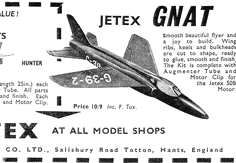
- Aeromodeller, Jan. 1956 (p. 6)
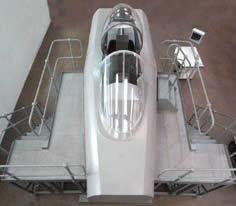 
- Model Aircraft, Apr. 1956 (p. xi)
|
|
|
|
|||||
|
New fuel Wilmot Mansour had contracted the manufacture of Jetex fuel
to ICI, who by 1956 were finding this line of minor significance and minimal
profit. (Wilmot Mansour themselves sold the fuel at cost.) ICI took the
opportunity offered by the change of Jetex ownership to withdraw from fuel
manufacture (they had withdrawn from sponsoring the ICI Challenge Trophy
after the last contest in 1954). Sebel took on the task of propellant manufacture, resulting in new Sebel fuel coming on the market in 1959 (right). It was produced to a different guandine nitrate/potassium dichromate formulation (patented in the name of New motors The higher temperature of the new Sebel fuel proved unsuitable for the duralumin cases of the Wilmot Mansour motors and Sebel introduced new steel cases. The 50B motor, for example, became the steel-cased 50C, preserving the same configuration but able to withstand the new fuel's combustion temperature. In the case of the Jetmaster, Sebel replaced it with the PAA-Loader motor (right), named for the US New kits Whereas many of the Wilmot Mansour kits had been of duration models, the new Sebel kits decidedly favoured the scale modeller. The most notable introduction in this area was the series of ‘Tailored’ kits.
The sun sets on the heyday – 1960 - 1972
|
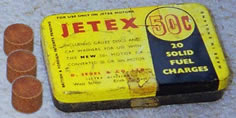
- Andy Blackwell

- American Modeler, Apr. 1957 (p. 46)
|
|||||
|
At the start of the 1960s, despite the transfer to Sebel (and in some respects, because of it), Jetex was in a sound position, both in the marketplace and in the modelling community. Sebel was a major exhibitor at the British Toy Fair of 1961, with a full show of Jetex kits and ready-builts. It was, however, a sign of the way the wind was blowing that the prime Jetex exhibit and the latest Bert Judge design was a rubber-powered indoor model (right). Jetex-powered contest flying was certainly in decline in the UK by 1960. From a peak in 1951, when Bill Henderson had won the SMAE Jetex Challenge Cup against 52 fellow competitors, entries in the event had declined to a tiny band of three in 1960. After a swan-song increase in the following year to 14 entries, the event was discontinued (and the whereabouts of the cup forgotten). In the US, contest flying achieved a peak with strong entries in the Jetex classes of the 1958 and 1959 PAA-Load Contests (below right), which had added the Jetex events in 1956, but discontinued them in 1960. North American interest in contest flying persisted well beyond the decade, however, with a Rocket class for Jetex flyers in the US Nationals (bottom right). In 1971, for instance, there were five placings in each of three classes, and the Rocket event continued to be flown until at least 1983. A factor in the decline of interest in Jetex contest flying was increased competition from the new breed of small diesel and glowplug motors. Additionally, a certain novelty factor which Jetex had benefited from over the previous twelve years had undoubtedly also faded, particularly among some contest flyers who had initially felt the attraction of a new form of motive power. Nevertheless, Jetex interest remained high with the ‘hobby’ group of modellers, particularly in the US. While in the UK Jetex advertising and publication of plans became increasingly sporadic thorugh the 60s, in the US Flying Models, in particular, continued to publish plans and Jetex advertisements through to the end of the decade. Even so, obtaining satisfactory fuel and wick became an increasing problem. In response to an enquiry from Bill Henderson (now in Canada) in 1971, Bert Judge guardedly admitted that Sebel had “had a certain amount of difficulty with Jetex wick”. By the late 1960s, Sebel had begun to feel the effects of a general decline afflicting the British toy industry, which had come under siege from cheap Asian imports. Faced with dwindling profits, in 1970 Sebel accepted a buyout offer from John Bentley of Barclay Securities. The Barclay Toy Group was formed and by 1971 had also taken over Chad Valley, Charles Methuen and Tri-ang. Losses continued, however, and a major restructuring in 1972 saw the Erith factory closed down, with the cessation of Jetex and Mobo Toys production. Bill Henderson, again seeking wick, was informed by Barclay Toys that “the position on ‘Jetex’ is in abeyance”. In the end, the Jetex manufacturing equipment was sold for scrap. Coincidentally, this same year saw the death of Joe Mansour. The sun had truly set on the heyday of Jetex.
|
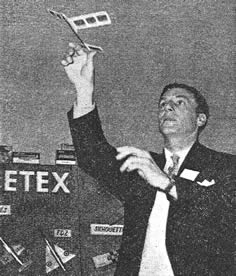 Bert Judge launches his new rubber indoor model at the British Toy Fair – in front of the Jetex stand!
- Aeromodeller, Apr. 1961 (p. 191)
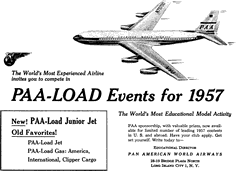 PAA announces a new Junior Jet class for the 1957 contest – though the actual entries were very far from resembling the Boeing 707 Clipper
- Air Trails Model Annual, 1957
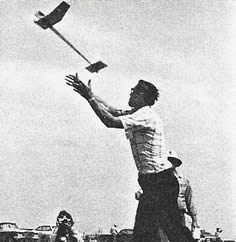 Into the sunset – Charlie Sotich launches his Jetex 100 powered Fizz-Dip at the 1971 US Nationals
- Aeromodeller, Oct. 1971 (p. 574)
|
|||||
|
|
|
|||||
|
|
|
|
|
|
|
|
Acknowledgements Text by John Miller Crawford, based on the following sources provided by MC Black, David Carpenter, Stuart Guy, Bill Henderson, Rolie Lelliott, Bruce Ogden and Ben Nead: - Editorial obituary: Joe Mansour, Aeromodeller, January 1973 - ‘Jetex’, Kenneth Brothwell. SAM 35 Yearbook #3, Dec. 1984, pp.138-149 - ‘Whatever happened to Jetex’, Kenneth Brothwell. Aeromodeller, Oct. 1985, pp.596-599 - Bill Henderson's personal correspondence with AA Judge (Wilmot Mansour/Sebel) - Letter over name of Barclay Toys Chief Inspector (H Black) to Bill Henderson - Personal correspondence of AW Thatcher (Wilmot Mansour staff, 1961- ) to Stuart Guy (Head of Engineering, GEL Engineering Ltd) - Personal correspondence with Steve Long (GEL Engineering Ltd) - Personal correspondence with MC Black, great-nephew of David Sebel Illustrations: - Andy Blackwell, Stuart Guy, Bill Henderson, Roger Simmonds, MAAC archives via Bill Henderson |
|
|
|
|
ABOUT | MOTORS | MODELS | ARCHIVE | HISTORY | STORE | FAQ | LINKS |
|
|
Terms of Use
|
Queries? Corrections? Additions?
Please
contact us.
|
|